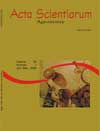<strong>Brassinosteroid and substrates in acclimatization of ‘Imperial’ pineapple</strong> - DOI: 10.4025/actasciagron.v30i3.3512
Keywords:
Ananas comosus, BIOBRAS-16, sugar-cane bagasse, filter cake, Plantmax®, growth regulator
Abstract
This work aimed to evaluate the effects of different concentrations of a brassinoesteroid analogue (BIOBRAS-16) and two substrates on the growth of micropropagated seedlings of “Imperial” pineapple. A randomized block design was used in a 2 x 5 x 4 factorial scheme, evaluating five concentrations of BIOBRAS-16 (0; 0.1; 0.3; 0.5 and 1 mg L-1), two types of substrates and four sampling periods (60, 90, 120 and 150 days after planting). The substrates used were Plantmax® and another obtained from a mix of composting sugar-cane bagasse and filter cake (CC). The seedlings were transplanted to small conic tubes and allocated in a greenhouse equipped with an intermittent mist. The plants cultivated in CC substrate and sprayed with 0.1 mg L-1 of BIOBRAS-16 showed higher growth of shoots with greater numbers of leaves, rosette diameter, leaf width, fresh and dry matter production at 150 days after planting. The plants that were cultivated on CC substrate and sprayed with BIOBRAS-16 at a 0.1 mg L-1 produced 2.8 times more dry matter than the control cultivated in Plantmax® substrate. The fresh and dry matter of roots were superior in Plantmax® when compared to CC at late sampling periods.Downloads
Download data is not yet available.
Published
2008-05-27
How to Cite
Catunda, P. H. A., Marinho, C. S., Gomes, M. M. de A., & Carvalho, A. J. C. de. (2008). <strong>Brassinosteroid and substrates in acclimatization of ‘Imperial’ pineapple</strong> - DOI: 10.4025/actasciagron.v30i3.3512. Acta Scientiarum. Agronomy, 30(3), 345-352. https://doi.org/10.4025/actasciagron.v30i3.3512
Issue
Section
Crop Production
DECLARATION OF ORIGINALITY AND COPYRIGHTS
I Declare that current article is original and has not been submitted for publication, in part or in whole, to any other national or international journal.
The copyrights belong exclusively to the authors. Published content is licensed under Creative Commons Attribution 4.0 (CC BY 4.0) guidelines, which allows sharing (copy and distribution of the material in any medium or format) and adaptation (remix, transform, and build upon the material) for any purpose, even commercially, under the terms of attribution.
2.0
2019CiteScore
60th percentile
Powered by 

2.0
2019CiteScore
60th percentile
Powered by 



















































